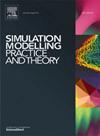软复合磁齿轮磁芯尺寸和功率损耗的减小
IF 3.5
2区 计算机科学
Q2 COMPUTER SCIENCE, INTERDISCIPLINARY APPLICATIONS
引用次数: 0
摘要
本研究旨在将同轴磁齿轮应用于汽车动力传动系统中,以实现高效率的小体积转矩传递。本研究对含孤立铁颗粒的无取向电工钢(M400-50A)、钴合金钢(Vacodur 50)和软磁复合材料(Somoloy 700HR 5P)的磁性能进行了详细的研究。对高速侧为6000转/分,低速侧为1800转/分,传动比为3.33:1的同轴磁齿轮,进行了材料在低、高频时的磁性比较。采用Ansys Maxwell 2D有限元软件对相同尺寸的磁力齿轮进行了功率损耗、体积转矩密度和效率分析。数值分析表明,与其他材料相比,Vacodur 50具有优越的性能。结果表明,在不改变磁体体积的情况下,磁性齿轮的尺寸比M400-50A提高了约2.67%,比Somoloy 700HR 5P提高了约4.17%,同时保持了相同的效率值。总之,使用Vacodur 50在磁性齿轮允许更紧凑的设计在车辆动力总成系统比其他材料。本文章由计算机程序翻译,如有差异,请以英文原文为准。
Reduction of core size and power losses of a soft composite magnetic gear
This study aims to achieve low-volume torque transmission with high efficiency by using a coaxial magnetic gear in vehicle powertrain systems. In this study, the magnetic properties of non-oriented electrical steel (M400–50A), cobalt alloy steel (Vacodur 50), and soft magnetic composite (Somoloy 700HR 5P) materials containing isolated iron particles are examined in detail. For the coaxial magnetic gear with a high-speed side of 6000 rpm, a low-speed side of 1800 rpm, and a 3.33:1 gear ratio, a magnetic comparison of the materials at low and high frequencies is presented. Power losses, volumetric torque density, and efficiency analyses for magnetic gears of the same size were performed using Ansys Maxwell 2D finite element software. The numerical analyses revealed that the Vacodur 50 provided superior performance compared to the other materials. It was found that without changing the magnet volume, the magnetic gear dimensions could be improved by approximately 2.67 % compared to M400–50A and by approximately 4.17 % compared to Somoloy 700HR 5P, while maintaining the same efficiency values. In conclusion, the use of Vacodur 50 in magnetic gears allows for more compact designs in vehicle powertrain systems than other materials.
求助全文
通过发布文献求助,成功后即可免费获取论文全文。
去求助
来源期刊

Simulation Modelling Practice and Theory
工程技术-计算机:跨学科应用
CiteScore
9.80
自引率
4.80%
发文量
142
审稿时长
21 days
期刊介绍:
The journal Simulation Modelling Practice and Theory provides a forum for original, high-quality papers dealing with any aspect of systems simulation and modelling.
The journal aims at being a reference and a powerful tool to all those professionally active and/or interested in the methods and applications of simulation. Submitted papers will be peer reviewed and must significantly contribute to modelling and simulation in general or use modelling and simulation in application areas.
Paper submission is solicited on:
• theoretical aspects of modelling and simulation including formal modelling, model-checking, random number generators, sensitivity analysis, variance reduction techniques, experimental design, meta-modelling, methods and algorithms for validation and verification, selection and comparison procedures etc.;
• methodology and application of modelling and simulation in any area, including computer systems, networks, real-time and embedded systems, mobile and intelligent agents, manufacturing and transportation systems, management, engineering, biomedical engineering, economics, ecology and environment, education, transaction handling, etc.;
• simulation languages and environments including those, specific to distributed computing, grid computing, high performance computers or computer networks, etc.;
• distributed and real-time simulation, simulation interoperability;
• tools for high performance computing simulation, including dedicated architectures and parallel computing.
 求助内容:
求助内容: 应助结果提醒方式:
应助结果提醒方式:


